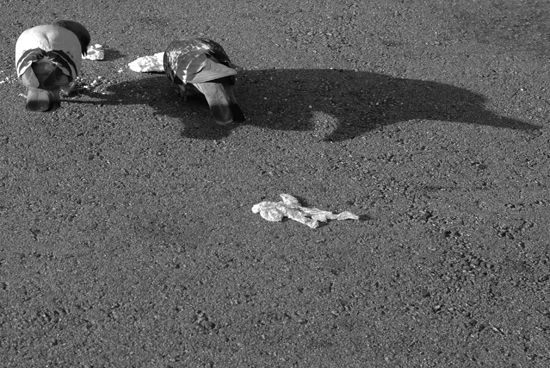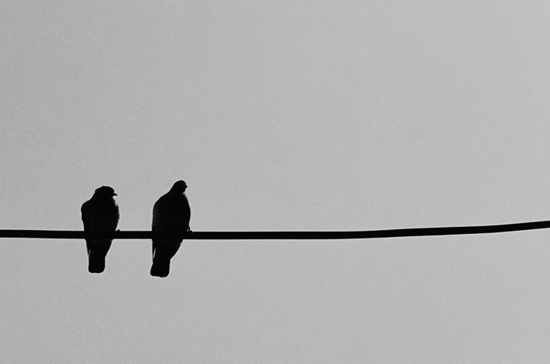
The maligned urban vertebrate known for its smoke-gray feathers and runny white spoor. The habitue of telephone wires. The bird who no one loves enough to cage. The terror of the bald man coming out of the BART underground as he ascends the escalator. The eternal foe of public monuments. The resourceful beast who makes nests of newspaper. Who raises its squabs on San Francisco’s eighth story windowsills, and its proud Victorian mouldings.
I walked behind my apartment, through the narrow hall there that empties into a small courtyard, and when I passed under an overhead walkway, an explosion of feathers flashed in front of me. I never saw the pigeon: I saw an electric gray blur. It startled, unsettled me. But the thought that this interstitial space between apartments was of some use to a living bird made me glad.

Pigeons, of course, are cousins to doves. Doves are supposed to be white, and to represent peace and union. Pigeons have less lofty associations. Yet the distinction between pigeons and doves, morphologically speaking, is blurry. When we speak of “hawks and doves,” what do we mean? Might we just as well say “hawks and pigeons”?

Pigeons and doves have considerable variation, but the one most widely known in Palestine, at least from my superficial research, is the common Rock Dove, or Rock Pigeon. In appearance, it is identical to the pigeon widespread in urban North America today: gray, with black bands on its wings and a tinge of green on its neck. Would it be sacreligious to suggest that paintings depicting Our Savior’s baptism might have been compromised by the artists’ ignorance of the Holy Land, or preconceived notions regarding color symbolism?
One new translation (called “Good as New” — admittedly a trendy one, as Bible translations go) has it that the most faithful rendering of John’s Gospel goes “A pigeon flew down and perched on him. Jesus took this as a sign that God’s Spirit was with him.” Allow me to suggest that if the image of a rugged, steel-colored bird with steady red eyes resting on Jesus’ naked shoulder seems blasphemous to you, the fault is entirely with you, and not the pigeon.

Pigeons, by most accounts, have been wrongly condemned. Though they do feed on our surplus grain if they can, they don’t transmit disease like rats do. They are well suited to our most vertical of cities, since their ancestral habitats were high, sheer cliffs. In their personal lives, pigeons are mild and private. They favor long relationships, have only one or two eggs at a time, and males and females share the duties feeding their young on a thick ambrosia (“crop milk”) regurgitated from their throats.
When I see these birds in my daily life in The City, I try not to take them for granted. I have seen them treated with scorn, shooed away, even spit on. I have seen kicks aimed in their direction, and it is solely to the credit of the pigeon that these kicks were not successful. I admit, when they descend in a flock on some discarded food wrapper, with greasy looking feathers around their necks, I have started to feel the contempt that has caused some to refer to the pigeon as “a rat with wings.”

Consider this. The passenger pigeon, similar to our own of today but larger in size and with feathers splashed with blue and orange, was once taken for granted, and now it is no longer with us. Billions of them once flew across America in flocks of hundreds of thousands. After the arrival of Europeans, they were harvested in massive numbers for cheap food, and fed to slaves and the poor. By 1914, what once might well have been the most numerous bird in history was extinct. Their small nests were ill-equipped for survival.
Let their cousins remind us, then, if not of some holy spirit stuffed into common feathers, than at least as a reminder of the pigeons that once were and now are no more (the sky once black with them, “a living wind“). Is there anything so terrifying to contemplate as an extinction? The irretrievable cessation of a unique form of life, lost for all seasons to come, and the startling reminder that we too, could go that way?
The common pigeon of today doesn’t, at present, need us to defend its survival.
But it could, I argue, use a little more respect.







